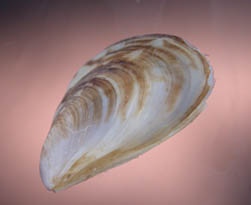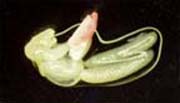Crayfish Transportation Restricted
 Researchers have discovered rusty crayfish, aggressive and invasive freshwater crustaceans, in Stagecoach Reservoir, Catamount Lake, the Yampa River in Routt County, at Sanchez Reservoir State Wildlife Area in Costilla County and Lake Granby.
Researchers have discovered rusty crayfish, aggressive and invasive freshwater crustaceans, in Stagecoach Reservoir, Catamount Lake, the Yampa River in Routt County, at Sanchez Reservoir State Wildlife Area in Costilla County and Lake Granby.
To prevent the spread of rusty crayfish, CPW regulations prohibit the removal of all live crayfish in waters west of the continental divide. Colorado law prohibits the use of rusty crayfish as bait anywhere in the state. Anglers collecting rusty crayfish for consumption must immediately kill the crayfish by separating the crayfish's tail from the body.
As of January 1, 2024, Colorado Parks and Wildlife allows the importation, transportation, and possession of live red swamp crayfish in Colorado for human consumption, provided the following conditions are met:
- No person may possess an individual of the species alive for more than 72 hours.
- Any person who possesses the species alive must have:
- a copy of an importation license that authorizes the importation of the crayfish in the person’s possession; and
- a receipt or delivery confirmation reflecting the date the person took possession of the crayfish.
To protect Colorado's lakes and rivers, it remains illegal to release them and illegal to use them as bait.
Whirling Disease and Colorado's Trout
Whirling disease is a parasitic condition affecting fish, primarily rainbow trout. It is present in many Colorado rivers and in a number of state hatcheries.
Once the disease parasite is established in the wild, it can persist indefinitely, depending on environmental conditions.
Efforts to reduce the parasite in hatcheries are proving successful.
Colorado Parks and Wildlife has developed strict policies and regulations to help control and prevent the spread of the disease in Colorado.
To find out how it affects fish and what you can do to help, see Whirling Disease.
Serious Threats to Aquatic Habitats - Mussels
 Zebra and quagga mussels are non-native barnacle-like mollusks with dark and light colored stripes. They smother aquatic organisms such as crayfish and native clams. They can also damage boating equipment and clog water treatment facilities.
Zebra and quagga mussels are non-native barnacle-like mollusks with dark and light colored stripes. They smother aquatic organisms such as crayfish and native clams. They can also damage boating equipment and clog water treatment facilities.
Zebra and quagga mussels spread from Eurasia to the Northeast and Great Lakes in contaminated ballast water of boats, on anchors and anchor lines. They quickly spread to the Mississippi River, its tributaries and inland lakes and have now established a presence in the Western States.
Boating regulations require mandatory boat inspections to prevent the spread of aquatic invasive species. For the most current information, including news releases, visit Boat Inspections.
Gill Lice in Colorado
 Salmincola, often called gill lice, are parasitic crustaceans that attach to trout and kokanee in both free-ranging and hatchery populations in Colorado. The parasites attach to and damage the gills so the fish cannot properly exchange gases and waste products. This causes the fish to be very susceptible to the impacts of stresses such as angling and catch‐and‐release activities.
Salmincola, often called gill lice, are parasitic crustaceans that attach to trout and kokanee in both free-ranging and hatchery populations in Colorado. The parasites attach to and damage the gills so the fish cannot properly exchange gases and waste products. This causes the fish to be very susceptible to the impacts of stresses such as angling and catch‐and‐release activities.
To learn more about how gill lice is affecting fish in Colorado and prevention methods, see Salmincola.
Hatcheries - Visit one near you!
The Colorado Parks and Wildlife operates 16 fish propagation facilities that include hatcheries, rearing units, and a native aquatic species restoration facility. Visitors are welcome at every facility. To learn more see the Hatcheries page.
Job opportunities - Learn about a career as a fish hatchery technician.
Contact your Aquatic Management Staff
Colorado Parks and Wildlife has
22 aquatic biologists that manage the aquatic resources of the State of Colorado by performing species inventories, setting fishing regulations, taking spawn from feral fish populations to propagate sportfish or for conservation of other rare species, developing annual fish stocking schedules, monitoring water quality and quantity, and by evaluating and enhancing fish habitat resources. Eighteen of these aquatic biologists are Area Aquatic Biologists and in general, are more responsible for the sportfish species where the four Native Aquatic Species Biologists are more responsible for the conservation of our native fish species.
These aquatic biologists are supervised by four regional Senior Aquatic Biologists. All of the biologists are supported by our
Senior Aquatic Staff.

